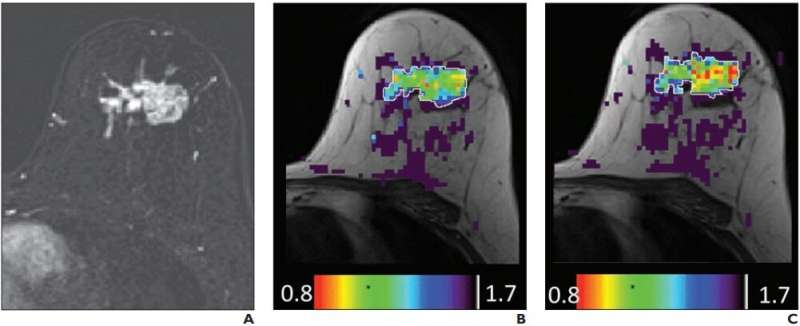Effect of gadolinium-based contrast agent on breast diffusion-tensor imaging

An "Original Research" article published in ARRS' American Journal of Roentgenology (AJR) concluded that the accuracy of breast cancer diagnosis via diffusion-tensor imaging (DTI) was equivalent both before and after the administration of a gadolinium-based contrast agent (GBCA), despite a value change in DTI parameters.
"However," wrote first author Anabel M. Scaranelo of Princess Margaret Cancer Centre's breast imaging division in Toronto, "the limitations in standardization of contrast enhancement implies that unenhanced diffusion measurements should be preferred."
In this pilot study, 26 women (age range 37-69 years) scheduled for a diagnostic breast MRI with BI-RADS categories 0, 4, 5, or 6 on conventional breast imaging were twice scanned using the same DTI sequence before and immediately after the breast dynamic contrast-enhanced MRI.
Using dedicated DTI software, quantitative image analysis yielded parametric DTI maps of each directional diffusion coefficient (DDC), mean diffusivity, and maximal anisotropy of the lesions and normal tissue. Using appropriate statistical tests, these color maps were evaluated and lesion DTI parameters were compared before and after GBCA administration.
Fifty-eight percent of the cohort had cancer (13 infiltrating ductal carcinoma, two ductal carcinoma in situ), and 42% had benign or normal results. All breast cancers were visually detected in the DDC λ1 maps before and after GBCA administration. Mean cancer size derived from λ1 maps before GBCA administration was 15.3 mm—not statistically significantly different from the size derived after GBCA administration.
After GBCA administration, the cancers exhibited statistically significantly lower DDCs, mean diffusivity, and b0 intensity (p < 0.05), and no change in maximal anisotropy compared with before GBCA administration, whereas these parameters in normal and benign lesions did not change significantly after GBCA administration. Mean AUC values before and after GBCA administration were not statistically significantly different for all parameters, aside from λ3.
Compared with before dynamic contrast enhancement, Scaranelo and colleagues' results showed statistically significant reduction in the DDCs of breast cancers after dynamic contrast enhancement, "leading to equivalent or increased conspicuity of the cancer lesions in the visual assessment by the radiologist," they noted.
Acknowledging the accuracy of breast cancer detection using unenhanced or contrast-enhanced DTI datasets was not significantly different, Scaranelo added that since DTI parameters are intrinsic tissue characteristics, the use of DTI before dynamic contrast enhancement can be fully standardized.
Scaranelo et al. explained further: "The contrast-enhanced DTI parameters are less amenable to standardization because their values depend on the type and dose of contrast agent and on variations in the contrast agent dynamics among the various types of breast cancers."
Thus, due to the lack of standardization of contrast-enhanced DTI, the authors of this AJR article still preferred unenhanced diffusion measurements.
More information: Anabel M. Scaranelo et al, Effect of IV Administration of a Gadolinium-Based Contrast Agent on Breast Diffusion-Tensor Imaging, American Journal of Roentgenology (2020). DOI: 10.2214/AJR.19.22085

















